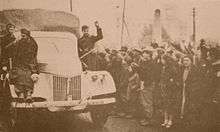Bulgarian Peoples Army
| Bulgarian People's Army Bulgarska Narodna Armiya | |
|---|---|
.svg.png) | |
| Motto |
"за нашата социалистическа родина!" Za nashata Soshtialistcheska rodina! (For the socialist motherland) |
| Founded | 1952 |
| Disbanded | 1990 |
| Service branches |
Bulgarian Land Forces Bulgarian Air Force Bulgarian Navy Bulgarian Air Defense Forces Bulgarian Missile Forces |
| Headquarters | Sofia |
| Leadership | |
| Minister of Peoples Defense | Dobri Dzhurov |
| Chief of the Defense | Hristo Dobrev |
| Manpower | |
| Conscription | Yes |
| Active personnel | 320,000 (1989) |
| Deployed personnel |
|
| Industry | |
| Foreign suppliers |
"Former" |
| Related articles | |
| History | Warsaw Pact invasion of Czechoslovakia |
The Bulgarian Peoples Army (BNA) (Bulgarian: Българска народна армия) was the military of the People's Republic of Bulgaria starting from 1946.
It comprised the Bulgarian Land Forces, Air Force and Navy. The BNA although did not play a major role in the Warsaw Pact in which the Bulgaria was one of its founders.[1] Specifically it was of the invading forces during the Warsaw Pact invasion of Czechoslovakia in 1968. However, other than this, the BNA did not see any combat during its existence. The Bulgarian Peoples Army dissolved along with the People's Republic of Bulgaria in 1990 and was succeeded by the Bulgarian Armed Forces.
History
The People's Republic of Bulgaria formed the BNA on September 8, 1944 after the Soviet Union invaded Bulgaria and installed the communist government.[2] In 1952 it was officially named the Bulgarian People's Army. In the period between 1948 and 1952 it was involved in repelling attacks by the Greek Army. It joined the Warsaw Pact on May 14, 1955 and activities in the alliance include the Warsaw Pact Invasion of Czechoslovakia. On October 23 the 22 Artillery Regiment that invaded the country withdrawed from Czechoslovakia. It advised North Korea in the Korean War and provided medical assistance to the troops of the DPRK.[3] It also advised the Viet Cong during the Vietnam War. During the 1950s, 60s and 70s the BNA assisted countries like Algeria, Yemen, Libya, Iraq, Nicaragua, Egypt, and Syria.

Composition
The BNA's manpower by the time the Peoples Republic was dissolved reached 120,000 men most who were conscripts. The combined strength of the Army, Navy, Air Force, Air Defense Forces, Missile Forces, plus the strength of the Peoples Militia and the Border Troops reached 320,000 in 1989.[4]
Equipment
The equipment of the BNA was mostly equipment provided by the Soviet Union. Some of this equipment were 500 combat aircraft (120 of which were Ilyushin Il-2), 3,000 (mostly T-34/85) tanks, 2,000 armored vehicles, 2,500 artillery systems, 33 navy vessels, 67 Scud missiles, and 24 SS-23 rocket launchers.[5]

Organization
The BNA has 5 main branches.
- The Land Forces
- The Navy
- The Air Force
- The Air Defense Forces
- The Missile Forces
Then there are the other branches that are under the direct control of the Ministry of National Defense.
- Civil Defense Service
- Signals Troops
- Transport Troops
- Border Troops
- Labor Forces
- Peoples' Militia
The combined strength of all of the forces was 325,000 in 1989[6]

References
- ↑ "Countries | The Cold War | National Cold War Exhibition". www.nationalcoldwarexhibition.org. Retrieved 2016-09-04.
- ↑ "Bulgaria - Table A. Chronology of Important Events". www.country-data.com. Retrieved 2016-09-04.
- ↑ "Who was involved? | The Armed Forces in the Korean War | Australia's involvement in the Korean War". korean-war.commemoration.gov.au. Retrieved 2016-09-05.
- ↑ "Bulgaria Armed Services - Flags, Maps, Economy, History, Climate, Natural Resources, Current Issues, International Agreements, Population, Social Statistics, Political System". www.photius.com. Retrieved 2016-09-25.
- ↑ "icweb2".
- ↑ "Bulgaria Armed Services - Flags, Maps, Economy, History, Climate, Natural Resources, Current Issues, International Agreements, Population, Social Statistics, Political System". www.photius.com. Retrieved 2016-09-16.